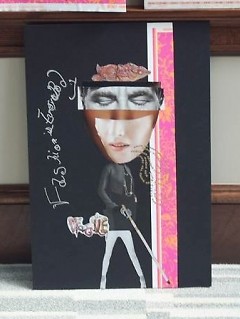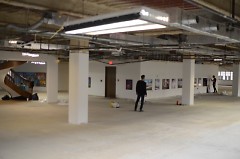KCDS 315 Collaborative Projects: An interdisciplinary experience providing an applied learning opportunity. Through an engagement with organizations, students will be introduced to all aspects of the project design process, with a focus to "whole systems design thinking."
Unless there happened to be a speaker during a portion of the six-hour day, students in Paul Amenta’s Collaborative Projects class from Kendall College of Art and Design collaborated the hours away focused on their client, Chris Smit, director of DisArt Festival. As the customer, Smit requested designs for signage, brochures, commemorative posters and wayfinding, supplying this student design team the DisArt Branding Guide. Amenta supplied this eager group, most of whom are Collaborative Design majors with various minors in other design fields such as graphics, furniture, industrial or interior design, with speakers and mentors with whom to interact on a weekly basis to keep the design process moving forward.
On a particular Friday, Smit joined the class to choose from the graphics design projects each group had been preparing for two months. He and his wife Elizabeth Van Arragon, DisArt Exhibitions Coordinator, arrived to assess and choose from the array of endeavors presented. They found colorful, meaningful, thoughtful and well-designed posters and graphics to assist with leading large groups throughout downtown during the festival as well as designs one would purchase as a commemoration of the fest.
One of the posters chosen for distribution at the various DisArt venues belongs to Ian Culver, a Graphic Design intern for DisArt, who is also a member of the KCDS 315 class. He worked with the DisArt team early in the 2014-2015 school year, and designed the DisArt logo being used on the "arts + access DisART Festival Guide." http://disartfestival.org/wp-content/uploads/2015/04/arts-access_Guide_W...
“The exposure I have encountered through Paul Amenta first discovering his work during ArtPrize 2014, and now having an opportunity to implement my own skills with him on DisART, has given me access to the big players involved in community collaboration,” says Culver.
Culver has shown his understanding of the process by utilizing the coordination of color and design throughout the collaborative process, which then becomes the “visual language of the festival and the important piece to take away,” says Smit.
Culver, as well as team partners Amar Džomba, Kat Matisse and Emily Nagy, worked with Chris Fox, Kendall graphics professor. They worked on balancing color, text and composition so anyone looking at the poster graphics is able to take it all in quickly. Achieving the delicate balance necessary in creating signage and wayfinding for masses of people involves a lot of collaborative dialogue about audience and the impact of seeing it up close as opposed to from far away. Part of this group’s presentation includes a challenge to the audiences that will be traversing the festival route downtown.
Gwen O’Brien of Plenty Design and Michael Schaefer, local artist, worked with Ben Schumitz, Hattie Straube and Jessica Rozema, superimposing layers of collage into edgy and relevant contemporary designs to depict abilities within disabilities. It should be noted that O’Brien and Schaefer, as well as other mentors mentioned here, all volunteered their time to work on this collaborative design project.
Students Jon Morrow, Eric Schroeder and Leslie Yarhouse were assigned to work with Brandon Satterlee of We Are the Forest, a local branding company. Along with graphics posters depicting Braille for persons with low vision and American Sign Language symbols for persons with hearing impairments, this group provided unique and creative sketches. One shows older model wheelchairs welded together to create seating. Another graphic displays an everyday item translated into an essential device for quadriplegics, and another of a bicycle rack/bench that is designed to neutralize an experience of sitting in a wheelchair.
Besides the graphics designs, this group of 10 organized themselves into two crews: physical space and digital tech. The two groups prepared 11,000 square feet of unused space downtown into an art gallery designed to accommodate those who are visibly designated as disabled, in particular those with mobility, vision and hearing impairments. The space includes windows on four sides with no walls, carpeting or ceiling tiles. The students were introduced to a raw and open space that needed serious thought, design and organization in order to accommodate local artists with disabilities chosen to exhibit their work during DisArt.
Since January, I have been able to witness this group of 10 students neutralize their own tensions surrounding working with their client in a wheelchair, Dr Chris Smit. I have had the fortune of being asked to return each Friday observing first-hand the design process in action, thus becoming a sort of mentor to the entire class. Witnessing the transformation of this collaborative group move from uninformed, hesitant and anxious to participating, motivated and involved under the direction of Paul Amenta and the resources of the Collaborative Design department has been enlightening and inspiring.
Graphic signage and posters have been printed and 11,000 square feet of space is being transformed into a unique arena for viewing. The DisArt Festival begins Friday April 10 with a huge celebration that coincides with Art.Downtown. and extends until April 25 with a closing at Wealthy Theatre.
The Rapidian, a program of the 501(c)3 nonprofit Community Media Center, relies on the community’s support to help cover the cost of training reporters and publishing content.
We need your help.
If each of our readers and content creators who values this community platform help support its creation and maintenance, The Rapidian can continue to educate and facilitate a conversation around issues for years to come.
Please support The Rapidian and make a contribution today.


